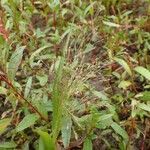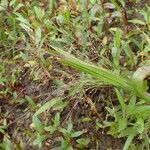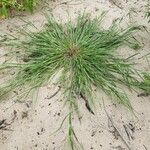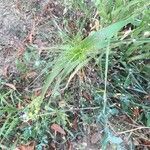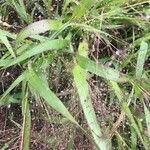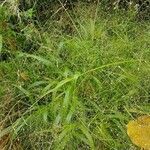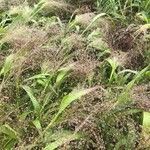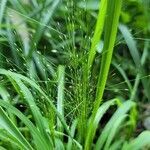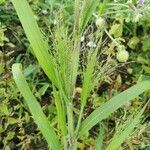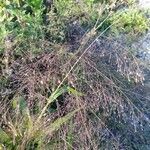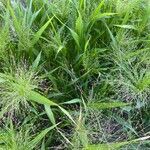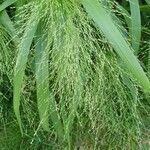Tufted summer annuals. Leaf-sheath light green to purplish, rounded, densely villous, hairs fine, soft, tubercle-based. Ligule 1-2 mm, a truncate membranous ciliate rim. Leaf-blade 7.5-15-(30) cm × 3-9-(12) mm, rounded at base, gradually narrowed above, light green, rather thin, usually villous with scattered, fine, tubercle-based hairs, midrib obvious; margins finely scabrid, often undulate, tip acuminate. Culm (7.5)-15-30-(45) cm, erect, slightly compressed, nodes densely pubescent, internodes villous with long tubercle-based hairs, or glabrous. Panicle 15-40 × 4-15 cm, often ½ length of plant, very diffuse, with fine branches at first ascending, later spreading; rachis and branches with scattered hairs, finer branchlets and pedicels scabrid; whole panicle detaching at maturity and blown by the wind. Spikelets 2.3-3 mm, glabrous except at tip, light green or purplish, elliptic, narrowed to acute or acuminate tip. Lower glume < ½ length of spikelet, ovate-triangular, 5-nerved, acute, tipped by minute hairs, upper = spikelet, 7-9-nerved, elliptic, tapered above to acute, very minutely ciliate apex. Lower floret Ø: lemma very slightly < upper glume, 5-nerved, elliptic, dorsally flattened, laterally incurved, tapered above to acute, very minutely ciliate apex; palea 0. Upper floret ☿: lemma 1.5-2 mm, elliptic, subacute, faintly striolate, glabrous, shining, light cream; palea narrow; anthers 0.8-1.3 mm; caryopsis c. 1.5 mm.
More
Coarse, rough-hairy annual to 7 dm, branched from the base, erect or ascending or in depauperate forms spreading; lvs 6–17 mm wide; panicles diffusely branched, sometimes two-thirds as long as the whole plant; axillary pulvini glabrous to evidently hairy; spikelets all or mostly on long pedicels, acute to acuminate, 1.8–3.5 mm, the first glume a third to half as long as the sterile lemma; fr stramineous, 1.4–2 mm, a third as wide; margins of the lemma distinctly inrolled, the visible part of the palea a third to half as wide as the fr; 2n=18. Dry or moist soil, often a weed in fields and gardens, widespread throughout most of the U.S. and s. Can. (P. barbipulvinatum; P. gattingeri)
An annual grass. It forms tufts. It grows up to 60 cm tall. It spreads to 30 cm across. The leaves are 7-30 cm long by 5-14 mm wide. They are flat. The flower panicle is broad and 15-50 cm long. The spikelets are on long thin stalks. The flowers are green.
